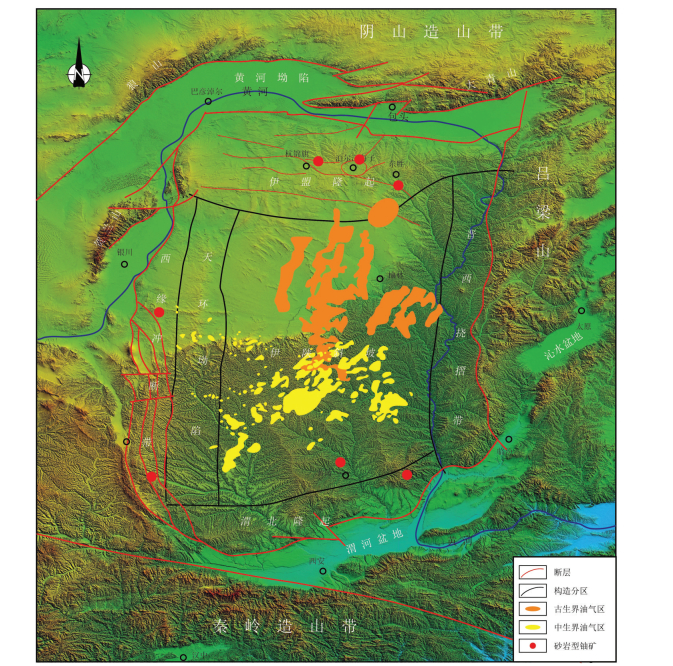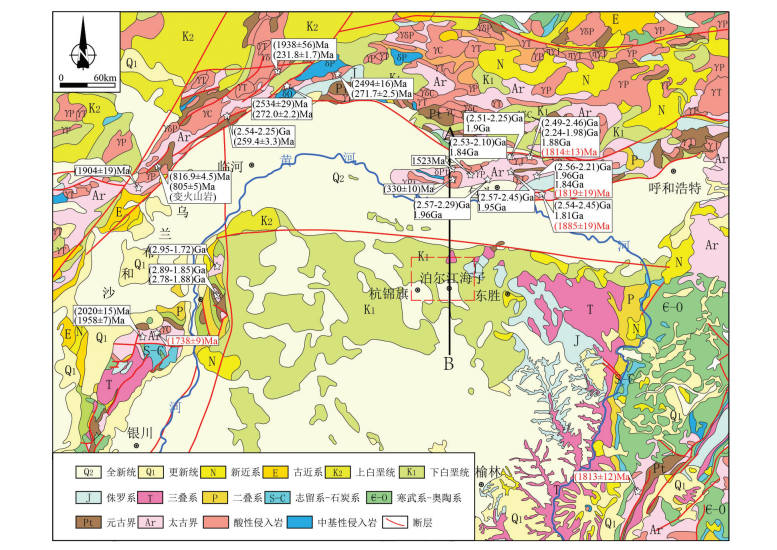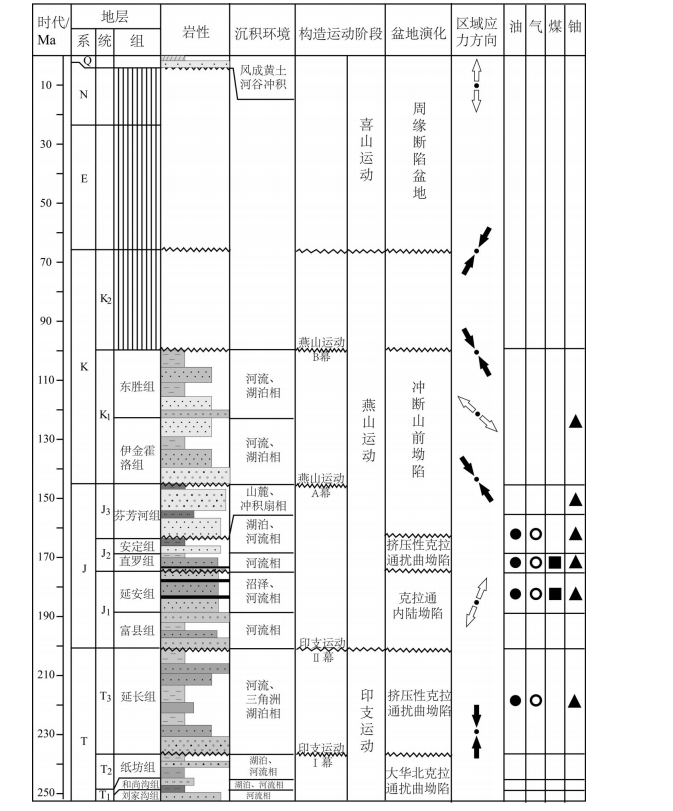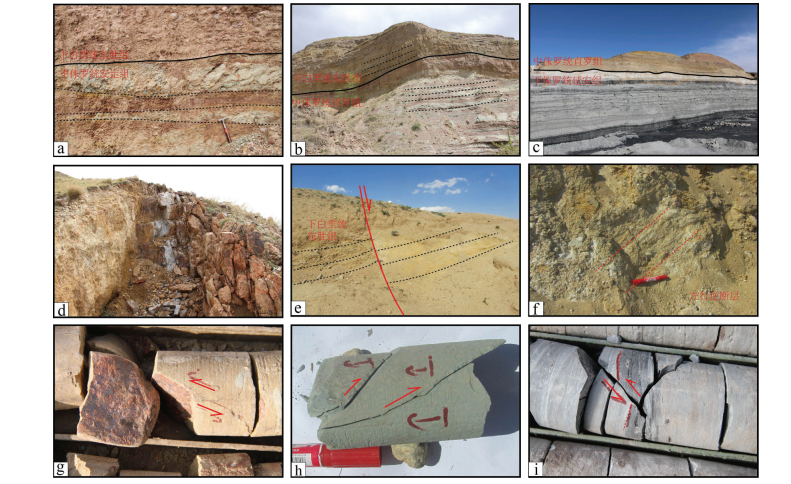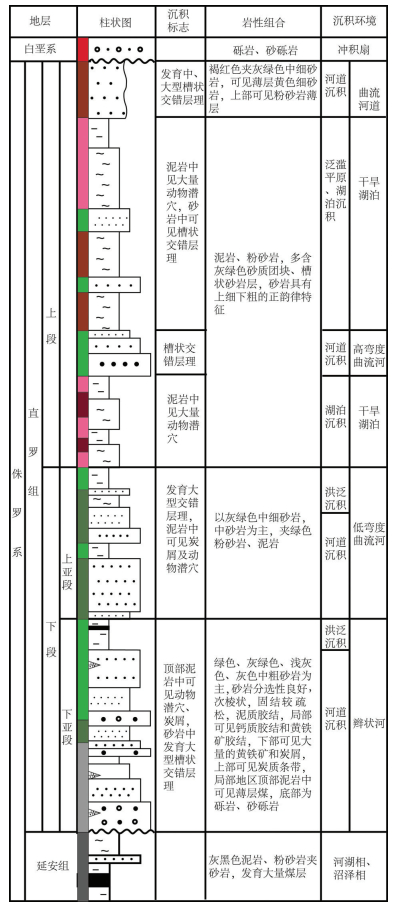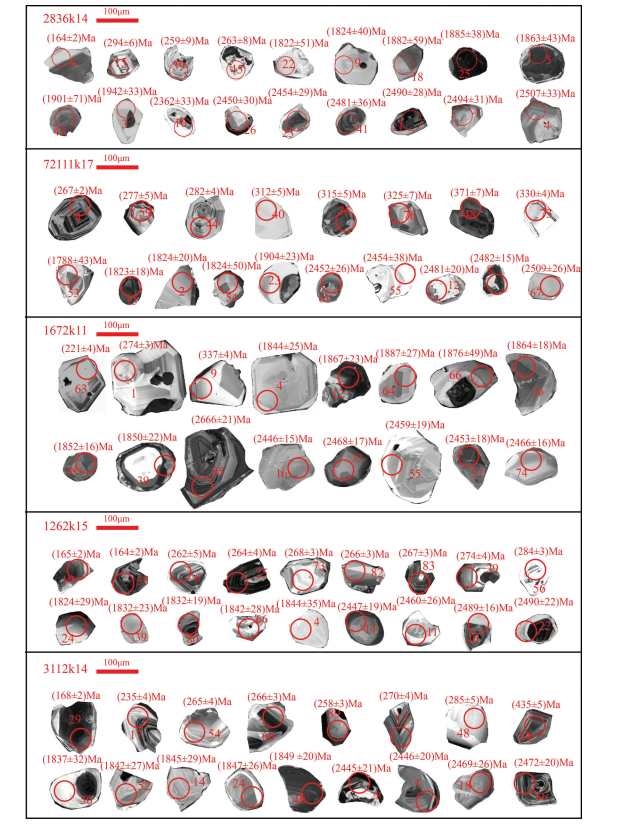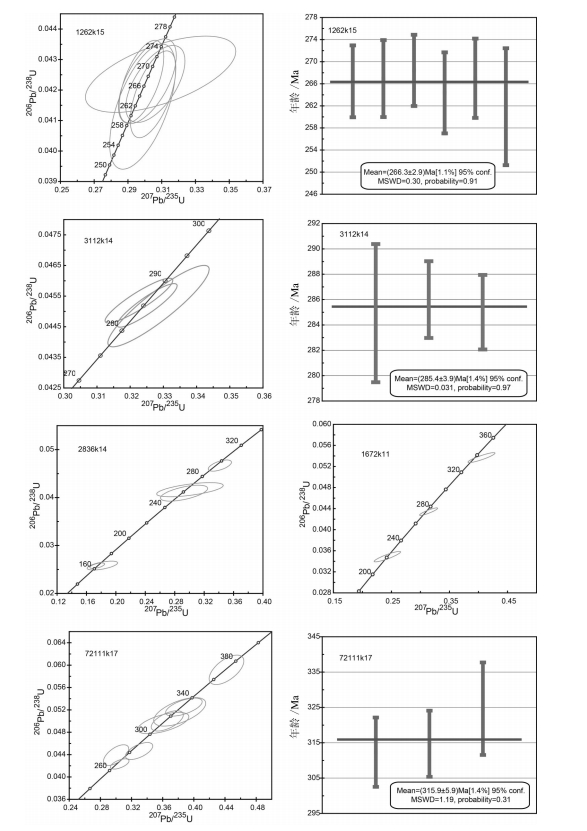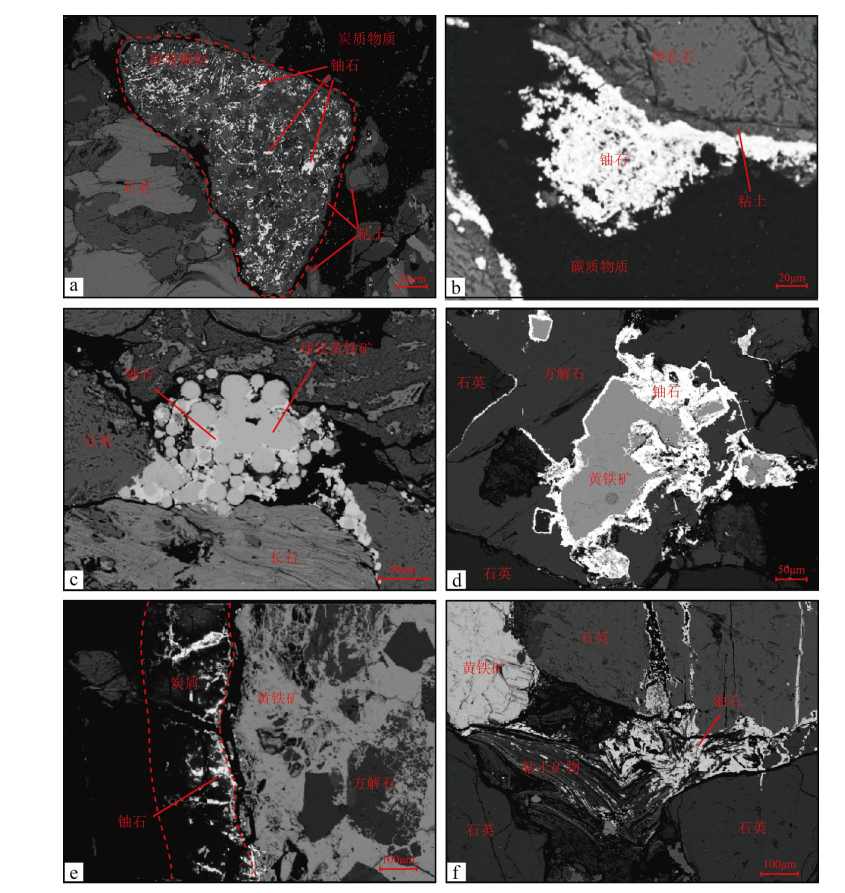An analysis of U-Pb dating of detrital zircons and modes of occurrence of uranium minerals in the Zhiluo Formation of northeastern Ordos Basin and their indication to uranium sources
-
摘要:
鄂尔多斯盆地作为中国重要的多种能源共生的大型盆地,发育了大量的砂岩型铀矿床。本次工作选择盆地东北部纳岭沟铀矿床作为研究对象,在直罗组含矿段附近采取5个砂岩样品进行碎屑锆石U-Pb定年,并针对含矿样品进行电子探针分析。该地区直罗组含矿段碎屑锆石U-Pb年龄集中分布于5个阶段:(2479±11)Ma~(2460±19)Ma、(2300~1950)Ma、(1896±21)Ma~(1820±32)Ma、(316~266)Ma及165 Ma。同时,本文整理了鄂尔多斯盆地北部造山带内古老变质基底、孔兹岩带和晚古生代侵入岩时代,并发现在直罗组内获得的碎屑锆石年龄与北部造山带内地质体所记录的年龄相一致。结合前人地球化学及古地理研究,本次工作推断纳岭沟地区直罗组砂岩沉积物最终来自于鄂尔多斯盆地北部造山带。纳岭沟铀矿床内铀矿赋存形式主要为存在于碎屑颗粒内部、黏土矿物周边、黄铁矿周边和炭屑裂隙内部。结合野外地质体放射性异常测量,本次工作认为铀源主要来自于沉积成岩阶段含铀碎屑颗粒的预富集和后期高放射性异常地质体通过含铀含氧水向盆地内部的迁移。
Abstract:The Ordos Basin is an important large basin with multi-energy resources, around which a series of sandstone-type uranium deposits are developed. The Nalinggou uranium deposit located in the northeastern part was chosen as a study object. Five sandstone samples surrounding the ore-bearing segment in the Zhiluo Formation were selected to make detrital zircon U-Pb dating, while electron microprobe analysis was performed for some sandstone samples with uranium minerals. The ages are distributed as 5 major peaks:(2479±11) Ma-(2460±19) Ma, (2300-1950)Ma, (1896±21) Ma-(1820±32) Ma, (316-266) Ma and 165 Ma. The authors further arranged the age data of metamorphosed basement, khondalite belt and Late Paleozoic intrusions in the orogenic belt on the north margin of the Ordos Basin. These zones of detrital zircons ages are consistent with the ages of geological bodies in the orogenic belts on the northern margin of the Ordos Basin. Combined with the previous work about geochemistry and paleogeography, the authors hold that the provenance of sandstone of Zhiluo Formation in Nalinggou area was finally derived from the orogenic belt on the northern margin of the Ordos Basin. The uranium minerals are spread in and around the clastic grains, clay minerals, pyrites, and fractures in charcoal fragments. The radioactive anomaly measurement in the field work shows that the uranium source probably came from the pre-enrichment of clastic grains from the provenance at the diagenetic stage, and from the migration of the uranium-and oxygen-bearing water through later leaching of the highly radioactive bodies of the provenance.
-
Keywords:
- Ordos Basin /
- Zhiluo Formation /
- detrital zircon /
- U-Pb dating /
- uranium deposit
-
1. 引言
西藏是中国地热活动尤为强烈的地区之一,在全国现已查明的3000余处水热活动区中,西藏境内就有677处(佟伟等,2000),可供开发的地热显示达342处,绝大部分温度超过80 ℃。西藏地热具有温度高、类型多、分布广等特点,具罕见水热爆炸的羊八井、国内最大间歇喷泉——搭格架间歇泉、卡乌泉塘沸泥泉等均闻名于世。西藏地热划分为藏北低—中温水区、“三江”上游中—高温热水区及藏南部谷地高—中温水汽区三大区,藏南部谷地高—中温水汽区又以热田出露多、类型全、规模大而出名(佟伟等,1981)。西藏地热的分布严格受活动断裂控制,且与区域大地热流背景关系密切(魏斯禹等,1981)。以藏南部谷地高—中温水汽显示区为例,沿喜马拉雅弧形构造带发育众多总体SN向且由一系列隆起带、断陷带及断裂带组成的活动构造带(干成,1980;贺日政等,2003),形成一系列第四纪断陷盆地,盆地内发育强烈的现代水热活动,即著名的喜马拉雅大型地热带(王鹏等,2016),朗久、搭格架、卡乌、羊八井、古堆等地热田均展布于此。目前,西藏已在羊八井、搭格架、古堆等地热田开展了地热资源调查及研究工作,以羊八井地热研究最为丰富,主要从羊八井地热田的地热地质条件(沈显杰,1984;多吉等,2003)、水文地球化学(赵平等,1998;Guo Qinghai et al,2007, 2009)、气体地球化学及地球物理特征(安可士等,1980)等方面,研究了羊八井热储、热源及补径排关系,建立了羊八井高温地热系统概念模型,估算了地热资源量,为西藏地热资源的研究奠定了基础。其他热田中,张萌(2014)利用混合模型估算了谷露热田热储温度,计算了冷水混合比;王尊波等(2015)认为搭格架热田存在尚未完全冷却的侵入岩体热源;沈立成(2011)提出朗久地热田和搭格架地热田不同的CO2的脱气机理和CO2的脱气量计算公式,并计算了CO2的脱气通量;王思琪(2017)认为埋藏较浅的局部熔融体、高温岩体或热流体为古堆热田良好的热源,而SN向发育的沃卡—古堆—错那深大区域性断裂带为深部热能传递大通道;李明礼(2015)认为日多温泉中高含量的B、Li、Sr主要来源于深部热流体对火山岩地层长时间的强烈溶滤作用。西藏地热研究成果丰富,但多局限于以单体热田为单位,对沿近SN向断裂带展布的地热显示分布规律及特征研究有限且不全面。刘昭(2014)对雅鲁藏布江以北段当雄—羊八井—多庆错SN向发育的活动断裂带高温地热进行了较为系统的研究,提出了带内高温地热系统概念模型,为西藏活动断裂带地热形成机制的系统研究提供了方向。
错那—沃卡裂谷带是藏南裂谷带最东侧的SN向断裂带,由沃卡、邛多江和错那—拿日雍错3个相互独立、断续分布的地堑式盆地组成,盆地内地热显示丰富,分布有西藏第二大地热显示区—古堆热田,有色吾温泉、沃卡地热和日多温泉。沃卡地热显示区位于错那—沃卡裂谷北段的沃卡断堑内,沿增久曲河谷及斜坡均有规模大小、温度不一的地热显示,长度达3 km,其类型有温泉、温水沼泽和放热地面,水温43~68.2 ℃,属中低温地下热水系统,但张丰述(2008)等在沃卡地堑北段卡乃温泉露头所在河谷施工供水井时于60 m揭露了温度高达80 ℃的热水,表明沃卡地热区热水受地表冷水混合影响强烈,具有中高温地热系统开发的潜力。沃卡盆地区域地热地质研究程度低,仅宋凯(2011)、贺咏梅(2016)进行的沃卡温泉水化学、氢氧同位素特征研究,但对沃卡温泉与活动断裂控制成因模式的研究较为薄弱,其热储、热源等尚不清楚,开发价值及潜力难以评判,造成了沃卡温泉仅作为洗浴功用的单一开发模式。因此,开展沃卡地热系统成因机制研究,可为沃卡盆地地热资源潜力的精准评估提供科学指导,对推动沃卡地热的可持续开发利用,促进山南地区地热经济发展和“精准扶贫”工程建设,具有重要的现实意义。
本研究在搜集已有研究成果基础上,通过地热地质调查、温泉水化学及同位素分析,对沃卡地热区温泉水文地球化学特征、热储温度、地下冷水混合比等进行系统研究,建立沃卡地热区中—高温地热系统概念模式,对完善错那—沃卡断裂带地热形成机制,继而丰富西藏中高温地热系统的成因机理具有重要的理论意义。
2. 研究区概况
2.1 自然地理
研究区位于西藏山南市桑日县增期乡以南,距离桑日县城40 km,区内有桑日县—墨竹工卡县X302县道,交通便利。研究区属高山河谷地貌,河谷宽缓,发育冰碛台地及丘陵地貌;岸坡陡峭,地形坡度30°~50°,高差1000~1500 m。区内气候属于高原温带季风半湿润气候区,年平均气温6.4 ~8.2 ℃,年平均降水量500~600 mm,主要集中在5—9月,占全年降雨量的89%以上。降雨具年变化差异大、降雨期集中特征。
沃卡断陷盆地地下热水系统,为沿沃卡地堑盆地内增久曲河谷分布的众多温泉的统称,其现有地热显示22处,总流量大于20 L/s(表 1)。根据地下热水出露特征、开发利用现状,可分为卡乃温泉、沃卡温泉和阿玛卡温泉。此外,沿断堑盆地南侧雅鲁藏布江两岸出露有沃卡河口微温泉、竹磨沙热泉(佟伟等,2000),但现已消失。
表 1 地下热水出露特征Table 1. Exposure features of underground hot water
2.2 地层岩性
沃卡地热显示区沿河谷一带出露第四系全新统冲洪积物(Qhpal),具有明显的二元结构,上部为浅黄色含亚砂土或含砾亚砂土,下部为杂色卵石、漂石及含泥质卵石。两岸分布有白垩纪—古近纪黑云母二长花岗岩(ηγβΚ2)、花岗闪长岩(γδΚ1)、石英闪长岩(δοK1)等;沿分水岭一带出露侏罗系中下统叶巴组(J1-2y),分为3个岩性段,一段以含火山角砾岩、火山集块岩为特征,二段以中酸性安山岩、英安岩、流纹岩、晶屑岩屑凝灰岩为主,三段由沉凝灰岩、变质砂岩、粉砂岩等组成。沃卡地堑地热地质背景见图 1。
![]() 图 1 沃卡地堑盆地地质背景图1—全新世洪冲积物;2—全新世冲积物;3-更新世冰川堆积物;4—古近系火山岩;5—晚侏罗纪—白垩纪;6—侏罗纪火山岩、陆源碎屑岩沉积组合;7—多底沟组灰岩;8—晚三叠世;9—麦隆岗组;10—松多组;11—侏罗纪—白垩纪混杂岩;12—白垩纪—新近纪侵入岩;13—超基性岩块;14—断层及编号;15—韧性剪切带及编号;16—逆断层;17—推测断层;18—地质界线;19-水系;20—乡镇/城市;21—冷泉;22—温泉;23—温泉遗址;24—断堑盆地范围Figure 1. Geological background map of Oiga Graben basin1-Holocene alluvial deposits; 2-Holocene alluvium; 3-Pleistocene glacial deposits; 4-Paleogene volcanic rocks; 5-Late Jurassic and Cretaceous; 6-Sedimentary assemblage of Jurassic volcanic and continental clastic rocks; 7-Duodigou Formation limestone; 8-Late Triassic; 9-Mailonggang Formation; 10-Songduo Formation; 11-Jurassic-Cretaceous melange; 12-Cretaceous-Neogene intrusive rocks; 13-Ultrabasic block; 14-Fault and its number; 15-Ductile shear zone and its number; 16-Reverse fault; 17-Inferred fault; 18-Geological boundary; 19-River system; 20-Town/City; 21-Spring; 22-Hot spring; 23-Hot spring site; 24-Range of fault graben basin
图 1 沃卡地堑盆地地质背景图1—全新世洪冲积物;2—全新世冲积物;3-更新世冰川堆积物;4—古近系火山岩;5—晚侏罗纪—白垩纪;6—侏罗纪火山岩、陆源碎屑岩沉积组合;7—多底沟组灰岩;8—晚三叠世;9—麦隆岗组;10—松多组;11—侏罗纪—白垩纪混杂岩;12—白垩纪—新近纪侵入岩;13—超基性岩块;14—断层及编号;15—韧性剪切带及编号;16—逆断层;17—推测断层;18—地质界线;19-水系;20—乡镇/城市;21—冷泉;22—温泉;23—温泉遗址;24—断堑盆地范围Figure 1. Geological background map of Oiga Graben basin1-Holocene alluvial deposits; 2-Holocene alluvium; 3-Pleistocene glacial deposits; 4-Paleogene volcanic rocks; 5-Late Jurassic and Cretaceous; 6-Sedimentary assemblage of Jurassic volcanic and continental clastic rocks; 7-Duodigou Formation limestone; 8-Late Triassic; 9-Mailonggang Formation; 10-Songduo Formation; 11-Jurassic-Cretaceous melange; 12-Cretaceous-Neogene intrusive rocks; 13-Ultrabasic block; 14-Fault and its number; 15-Ductile shear zone and its number; 16-Reverse fault; 17-Inferred fault; 18-Geological boundary; 19-River system; 20-Town/City; 21-Spring; 22-Hot spring; 23-Hot spring site; 24-Range of fault graben basin2.3 构造条件
沃卡盆地位于西藏南部近NS向发育裂谷—错那—沃卡裂谷的北段,为区域性伸展变形而形成的第四纪活动明显的地堑式断陷盆地,断堑盆地全长约50 km,北至金珠乡一带,南端终止于罗布莎铬铁矿。从区域上看,沃卡地堑南端被倾向南的逆冲断裂带−雅鲁藏布江缝合构造带及北段倾向北的雪拉—日多—帕洛断裂所围限,中间错断了近ES走向发育的莫村韧性断层、些锅断层(吴中海等,2007)。
控制沃卡盆地发育的主边界断裂带为整体呈NNE走向、倾向西侧、长50~60 km的盆地东缘正断层,同时依据多条高密度物探剖面,沿增久曲河谷存在电阻率小于50 Ω.m的超低阻区域,推测沃卡河谷内发育有隐伏断裂或有热液形式存在(刘健,2018)。同时,沃卡地堑盆地内地震活动频繁,断裂活动速率估算结果表明,该断裂带MIS 6以来的垂直活动速率介于0.4~0.9 mm/a(吴中海等,2008)。在长期地震活动作用下,沃卡地堑盆地形成了东西、南北向交叉发育的构造裂隙网络,为沃卡地堑盆地地下热水系统的发育提供了储存空间和径流通道。
3. 样品采集与处理
本次研究水样分别采集于2017年9月、2018年7月野外调查期间。2017年主要采集温泉水样4组,沿沃卡断裂上分布冷泉水样8组;72组氢氧同位素样于两年按流域统一采取,水化学样采样点分布见图 1。水样的采集与处理严格按照《地热资源地质勘查规范》(GB/T 11615−2010)执行;温泉及冷泉水样均开展全分析测试,由四川省华地新能源环保科技有限责任公司完成;氢氧同位素分析由四川省科源工程技术测试中心完成。水化学分析执行《饮用天然矿泉水检验方法》(GB 8538−2016)标准,δ2H和δ18O的测定依据《水中氢同位素锌还原法测定》(DZ/T 0184.19−1997)和《天然水中氧同位素二氧化碳−水平衡法测定》(DZ/T 0184.21−1997)标准。同时,本次工作搜集了笔者研究生期间参与的《林拉铁路长大隧道区域水文地质条件及水热活动研究》项目沃卡河口微温泉水化学数据。
4. 温泉水文地球化学特征
4.1 水化学特征
从表 2可知,沃卡地热区热水水化学中,阳离子以Na+、Ca2+、K+为主,阴离子主要为SO42-、Cl-,HCO3-次之,可溶性总固体150.8~744 mg/L,pH介于6.5~7.71,为中偏碱性淡水,水化学类型主要有SO4−Na型、SO4·Cl−Na型、HCO3·SO4−Na型。
表 2 沃卡地堑出露温泉水文地球化学成果Table 2. Hydrogeochemical results of Oiga Graben hot spring
断堑盆地内热水与基岩裂隙冷泉水化学特征具极大差异(图 2)。盆地内热水富含H2S,而贫CO2,其水化学类型受H2S影响,出现了SO4型、SO4·Cl型、HCO3·SO4型等较复杂的水化学类型,这与错那—沃卡裂谷带上日多温泉、古堆地热田一致。
据地下热水常量组分Schoeller指印图(图 3),热水中各离子均具规律性变化,揭示盆地内热水来源及形成模式具相似特征,而以沃卡温泉为典型,热水具有高SO42-特征,这与温泉露头浓烈的硫磺味吻合,但卡乃温泉、阿玛卡温泉中SO42-含量偏低,可能与地表水或浅部裂隙水混合相关。王思琪(2017)、李明礼(2015)认为热水中SO42-的来源主要为热水溶滤硫酸盐岩而来,仅少部分为深部流体携带的H2S。因此,沃卡地下热水中较高的SO42-主要来自安山质、流纹质熔岩等火山碎屑岩为主的叶巴组地层强烈的溶滤作用。
采用Phreeqc软件对热水饱和指数计算表明(表 3),除玉髓外,方解石和白云石等均处于未饱和状态,反映出地下热水径流途径较短、水岩作用弱。
表 3 地下热水饱和指数模拟结果Table 3. Simulation results in the saturation index of underground hot water
4.2 同位素特征
根据项目2017—2018年集中于桑日县增期乡增久曲流域(沃卡盆地流域)、米林县卧龙镇比扑曲流域及工布江达县、巴宜区等地采集的67组天然泉水、2组大气降水、3组高山湖水或冰雪融水的氢氧同位素样,绘制出δ2H-δ18O曲线图(图 4)。
结果表明,盆地内热水δ2H为-151.61‰~-158.98‰,δ18O为-19.41‰~-19.75‰,分布于全球大气降水方程线附近,说明地下热水主要接受大气降水补给,此外冰雪融水亦会渗入补给。温泉水与冷泉具有相似的氘过量参数d,说明热水不存在明显的氧漂移现象,揭示沃卡断堑地下热水系统大气降水补给、浅循环特征(宋美钰等,2018)。
5. 热储温度及循环深度计算
5.1 热储温度
(1)基于地热温标法的热储温度估算
温泉作为地下热水系统的天然露头,其温度受浅表地下水或地表水的混合常常偏低,不能代表实际热储的温度。因此,通常利用SiO2温标法、阳离子温标法等定量地球化学温标方法来计算深部热储的温度。由图 5可知,卡乃温泉、阿玛卡温泉都落在部分平衡区或混合水区,沃卡温泉落在未成熟水区,表明沃卡断堑盆地地下热水系统中热水与原岩水岩作用并未达到完全平衡,或者热水中混入了较大比例的不平衡状态的冷水(许鹏等,2018),阳离子温标法估算热储温度具有局限性。
SiO2温标估算的热储温度范围分别为97.86 ℃~125.56 ℃和99.14~122.88 ℃(表 4)。由Na−K−Mg平衡图(图 5)可知,沃卡温泉4个出露点均落在120~200℃等温线之间,据SiO2温标估算的热储温度均低于该范围,表明盆地内地下热水系统中热水在涌出地表过程中受到了浅层裂隙冷水或地表水的混合。
表 4 运用地球化学温标计算的热储温度值Table 4. The temperature of thermal storage calculated by geochemical temperature scale
(2)基于混合模型的热储温度估算
以上分析表明,沃卡盆地内温泉具有与浅部冷水混合特征,可建立混合模型估算深部的真实热储温度。模型方程为:

(1) 
(2) 式中:Sc为冷水的焓(J/g);Ss为泉水的终焓(J/g,100℃以下的饱和水焓等于水的摄氏温度数;100℃以上时,温度与饱和水焓的关系可从表 5中查出);Sh为热水初焓(J/g);ρcSiO2为冷水的SiO2质量浓度(mg/L);ρsSiO2为泉水的SiO2质量浓度(mg/L);ρhSiO2为热水的初始SiO2质量浓度(mg/L);X为冷水混合比例。
表 5 热水温度、焓以及SiO2质量浓度关系Table 5. Relationship of water temperature, enthalpy and mass concentration of SiO2
根据上述公式,冷水温度取沃卡当地年平均温度8.2 ℃,冷水SiO2含量取盆地内冷泉平均值。热水初温假定等于75~300 ℃,相应焓值由表 5可以查出。泉口温度和SiO2含量根据本次实测值。将各温度的焓和SiO2的质量浓度分别代入公式(1)、公式(2),求出不同温度下的X1和X2值,绘出不同温度下X与热水温度的曲线图(图 6),X1和X2曲线交点即为计算热储温度值。
![]() 图 6 深部热水温度与混入冷水比例图解X1为基于泉水露头温度计算的冷水混入曲线;X2为基于泉水SiO2含量计算的冷水混入曲线Figure 6. Diagram of the ratio of deep hot water temperature to mixed cold waterX1 is the cold water mixing curve calculated based on the spring outcrop temperature; X2 is the cold water mixing curve calculated based on the spring SiO2 content
图 6 深部热水温度与混入冷水比例图解X1为基于泉水露头温度计算的冷水混入曲线;X2为基于泉水SiO2含量计算的冷水混入曲线Figure 6. Diagram of the ratio of deep hot water temperature to mixed cold waterX1 is the cold water mixing curve calculated based on the spring outcrop temperature; X2 is the cold water mixing curve calculated based on the spring SiO2 content由图 6可知,卡乃温泉热储温度为200 ℃,冷水混入比例为76%;沃卡温泉热储温度为150 ℃,冷水混入比例为70%;阿玛卡温泉热储温度为175 ℃,冷水混入比例为83%;由此可见,沃卡断堑盆地地下热水系统属于高温热水系统,但受地表冷水混合作用强烈。基于混合模型估算的热储温度与Na−K−Mg平衡图上热储温度范围基本一致,能较为真实地反映沃卡地堑盆地地下热水系统热储温度值。
5.2 补给高程
大气降水同位素组成具有高程效应,可根据这一特征,利用δ18O同位素值计算温泉的补给高程。计算方程为:

式中,H为补给区高程,m;h为取样点高程,m;δG为温泉的δ18O值;δP为大气降水的δ18O值;K为大气降水δ18O高程梯度(δ/100m)。δ18O的梯度值的确定:本次沿增久曲由上游至下游选取了4个典型冷泉同位素分析结果,将δ18O与泉点出露高程拟合所得曲线为δ18O=-0.0037H-107.98,R2=0.9473,其拟合求取的高度梯度为0.37‰/100 m,与西藏地区0.31‰/100 m的高度梯度较为吻合。高程参照值确定:以真不错湖水作为高程参照点,其δ18O=-15.0‰。各温泉的补给高程计算成果见表 6,结果表明,沃卡地堑盆地地下热水系统补给高程5100~5300 m,与区域分布雪山所在高山盆地海拔一致。
表 6 沃卡地堑盆地地下热水补给高程Table 6. Supply elevation of underground hot water
6. 温泉形成机制讨论
6.1 温泉形成条件分析
6.1.1 热源分析
据已有西藏高温地热系统的研究资料,西藏地热的热源多是壳内局部熔融层的贡献,表现为具有高导和低重力异常(佟伟等,1978;沈显杰等,1990;谭捍东等,2006)。熔融体多呈串珠状排列,并在地表形成具线性展布特征的伸展断层和断陷带,在后期地质历史过程中逐渐形成以串珠状断陷盆地为地貌特征的断裂谷系,往往成为地下热水赋存的优势部位,孕育了尼木、羊八井、谷露等众多地热田。
据错那—墨竹工卡电阻率模型(谭捍东,2004)(图 7),沿古堆—雅鲁藏布江缝合带—墨竹工卡县一线上部地壳中存在巨厚的高阻体(Ⅳ), 在雅鲁藏布江沃卡一带最大埋深达20 km,是冈底斯花岗岩体的反映;而在其下方存在3个较大规模高导体(Ⅰ、Ⅱ、Ⅲ),总体北倾,愈近缝合带产状变陡、深度变深,是雅鲁藏布江缝合带的反映。高导体的发育,可说明在地壳中存在局部熔融体或热流体(张森琦等,2018),这与走向近平行发育的羊八井—当雄—谷露裂谷具有共性。
![]() Figure 7. Resistivity model from 2D CG inversion form Cona to Maizhokunggar (modified from Tan Handong et al., 2004, 2006)
Figure 7. Resistivity model from 2D CG inversion form Cona to Maizhokunggar (modified from Tan Handong et al., 2004, 2006)结合沃卡地堑内出露温泉水文地球化学特征,认为沃卡断堑存在深部局部熔融体,为沃卡地堑盆地地下热水系统提供了良好的热源条件。
6.1.2 运移通道分析
沃卡盆地内纵横交错的断裂系统,为地下热水的形成提供了储存空间和运移通道。从地下热水系统发育构造部位来看,不同方向断裂交汇部位,是地下热水储存、运移、富集,直至排泄的优势部位,为地下热水活动发育强烈区。沃卡地热区主要控热构造可划分为北部热干—松多断裂构造带、中部莫村韧性断层构造带及南部雅鲁藏布江结合带构造带,呈EW向分布,均被近NS向的错那—沃卡断裂错断,组成断裂构造体系,这些构造交点构成了地下热水系统出露的有利位置。尤其是NS向断裂与EW向方向断裂的交汇处,既是热水水源的通道,又是地下热水运移和储存的空间,是地下热水系统最为活跃的部位,沿增久曲河谷温泉出露带存在宽约300 m的电阻率小于100 Ω·m的低电阻带即为有利的证据(图 8)。
沃卡地堑盆地内地震活动频繁,并伴随青藏高原强烈的构造活动呈现同步活跃之势,这种周期性的新构造活动所引起的地热活动强度交替,可解释竹磨沙热泉消失的原因。
6.1.3 地热流体来源分析
通过水文地球化学特征分析,盆地内温泉主要为大气降水、冰雪融水补给;热水在补给、径流以及排泄过程中受到水岩作用、冷水混入等影响,呈现出不同的水化学类型,基于混合模型的热储温度估算(黄广寿等,2020),区内温泉均有70%~83%比例不等的冷水混入;温泉氢氧同位素特征表明,区内温泉补给高程5100 ~5300 m。
6.1.4 热储特征分析
结合温泉水文地球化学特征,根据其热储特征,可将区内地热分为四系孔隙型热储、基岩裂隙型热储两种热储类型。
(1)第四系孔隙热储。根据物探成果,增久曲在沃卡段第四系松散覆盖层厚度50~150 m,其岩性为砂砾石,局部有致密砂层或热水胶结层作为盖层,热水在补给、径流过程中,沿河床基底发育的沃卡隐伏断裂或沃卡断堑盆地两侧边界断裂涌出,并在增久曲河谷一带进入具有良好透水性的第四系松散岩类孔隙中,形成良好的第四系孔隙热储层。
该热储层中地下热水的出露方式主要以温水沼泽为主,沿增久曲出露范围广,但越近地表水受混合作用明显,温度低,但钻孔可揭露高于天然出露温泉温度的地下热水。
(2)基岩裂隙型热储。该类热储主要分布于增久曲两岸基岩,其含水层为白垩系—古近系花岗岩侵入岩组成,受活动断裂影响,构造裂隙发育,富水性较好。构造裂隙的发育,既是热水运移的优势通道,又是热水储存的极佳空间。沃卡温泉多数泉口均沿花岗岩发育的裂隙流出,为区内地下热水的热储主体。
6.2 温泉概念模型建立
由于欧亚板块持续强烈的板块碰撞活动,在青藏高原形成了强烈而又频繁的构造变形,造就了下地壳深融型岩浆源区和中部的局部低速熔融层,并在上地壳的一定深度内,形成了浅层侵位的岩浆囊和不同深度的局部带状熔融体,为青藏高原地下热水系统的形成提供了必备的热源,因此青藏高原地热资源多属隆起山地对流型(王贵玲等,2017;周训等,2017)。综合西藏地区羊八井、尼木—那曲地热带等众多地热田的研究成果,建立了沃卡地堑盆地内地下热水系统概念模型(图 9)。
![]() 图 9 沃卡地堑盆地温泉成因模式图1—侏罗系中下统叶巴组;2—白垩系下统石英闪长岩;3—白垩系中统二长花岗岩;4—致密砂层盖层;5—第四系热储层通道;6—实测或推测断层;7—地质界线;8—补给冷水及运移方向;9—混合冷水及运移方向;10—热水及流动方向;11—温泉;12—温水沼泽;13—推测温度等值线;14—热源Figure 9. Origin model of hot spring in Oiga Graben basin1-Middle lower Jurassic Yeba Formation; 2-Lower Cretaceous quartz diorite; 3-Middle Cretaceous monzogranite; 4-Tight sand cover; 5-Channel of Quaternary thermal reservoir; 6-Measured or inferred fault; 7-Geological boundary; 8-Make up cold water and transport direction; 9-Mixed cold water and its migration direction; 10-Hot water and flow direction; 11-Hot spring; 12-Warm water swamp; 13-Inferred temperature contour; 14-Heat source
图 9 沃卡地堑盆地温泉成因模式图1—侏罗系中下统叶巴组;2—白垩系下统石英闪长岩;3—白垩系中统二长花岗岩;4—致密砂层盖层;5—第四系热储层通道;6—实测或推测断层;7—地质界线;8—补给冷水及运移方向;9—混合冷水及运移方向;10—热水及流动方向;11—温泉;12—温水沼泽;13—推测温度等值线;14—热源Figure 9. Origin model of hot spring in Oiga Graben basin1-Middle lower Jurassic Yeba Formation; 2-Lower Cretaceous quartz diorite; 3-Middle Cretaceous monzogranite; 4-Tight sand cover; 5-Channel of Quaternary thermal reservoir; 6-Measured or inferred fault; 7-Geological boundary; 8-Make up cold water and transport direction; 9-Mixed cold water and its migration direction; 10-Hot water and flow direction; 11-Hot spring; 12-Warm water swamp; 13-Inferred temperature contour; 14-Heat source沃卡地堑盆地两侧大气降水和高山冰雪融水为地下热水主要补给源,经接受补给的冷水沿构造活动发育的断裂不断下渗,经一定深度的局部带状熔融体提供热源加热,形成了地下热水,并伴随着深部气体成分的不断加入,热水开始向上运移,受控于条带状展布的受断裂控制的基岩裂隙型热储,为深部热储控制地下热水;在地下热水沿河谷基底断裂或盆地边界断裂上升过程中,由于浅层裂隙水的混合,其温度降低。在增久曲河谷内,热水沿基岩裂隙热储进入具有良好透水性的第四系松散岩类孔隙含水层中,以致密砂层或热水胶结层为盖层,形成第四系孔隙型浅部热储,在热水上升过程中受地表水的混合,沿河床一带形成温水沼泽。
7. 结论
(1)沃卡地堑盆地地下热水系统属于中—高温地热系统,地热显示主要沿沃卡半隐伏断裂呈带状展布。热水为中偏碱性水,可溶性总固体150.8 mg/L~744 mg/L,水化学类型主要有SO4−Na型、SO4·Cl−Na型、HCO3·SO4−Na型。
(2)热水水文地球化学特征表明,沃卡地下热水系统具有大气降水补给、浅循环地下水的特征,且受裂隙潜水或地表水的混合作用,热水在Na−K− Mg平衡图上处于部分平衡或混合水、未成熟水的范围内。
(3)利用二氧化硅温标对热储温度进行估算,其热储温度97.86~125.56 ℃,热水受浅层裂隙冷水或地表水的混合,估算热储温度偏低。通过建立热储温度混合模型,对热水热储真实温度及混入冷水比例进行估算,结果表明沃卡盆地地下热水真实热储温度范围为120~200 ℃,冷水混入比例为70%~ 83%。
(4)基于同位素高程效应特征,计算沃卡地堑盆地地下热水系统补给高程为5100~5300 m,主要为大气降雨及高山冰雪融水补给。
感谢: 在锆石U-Pb测试和电子探针测试过程中得到了天津地质调查中心实验室肖志斌、张永清和郭虎的大力支持,在样品采集过程中得到了中国核工业二〇八大队的大力支持,在此一致表示感谢。同时感谢评审专家及编辑提出的宝贵意见。 -
图 1 鄂尔多斯盆地DEM图及构造区域划分(参考于王建民等,2013)
Figure 1. DEM map of the Ordos Basin with regional tectonic division(modified from Wang et al., 2013)
图 2 鄂尔多斯盆地北部区域地质简图
(年龄数据据Li et al., 2009;Zhang et al., 2011;Gong et al., 2014, 2015;及其内部参考文献。黑色为锆石U-Pb年龄,红色为Ar/Ar年龄)
Figure 2. Geological map of the northern part of the Ordos Basin
(Ages are from Li et al., 2009; Zhang et al., 2011; Gong et al., 2014 & 2015; and references therein. The black color is zircon U-Pb dating. The red color is Ar/Ar dating.)
图 3 鄂尔多斯盆地北部S-N向地质剖面(剖面位置见图 2,参考Yang et al., 2015)
Figure 3. NS-trending cross-section through the northern part of the OrdosBasin (flocation see Fig. 2, after Yang et al., 2015)
图 4 鄂尔多斯盆地东北部地层综合柱状图(参考刘池洋等,2006;张岳桥等,2006;赵振宇等,2012)
Figure 4. Comprehensive stratigraphic column of the northeastern part of the Ordos Basin(modified from Liu et al., 2006; Zhang et al., 2006; Zhao et al., 2012)
图 5 鄂尔多斯盆地东北部野外及钻孔照片
a—纳岭沟铀矿区东北部下白垩统东胜组与中侏罗统安定组角度不整合接触;b—东胜东部神山沟地区下白垩统东胜组底部砾岩与下部中侏罗统直罗组杂色砂岩夹泥岩角度不整合接触;c—东胜东部神山沟地区中侏罗统直罗组与延安组角度不整合接触;d—鄂尔多斯盆地北部大桦背岩体周边变质岩内发育高γ放射性异常石英脉及钾长花岗伟晶岩岩脉;e—纳岭沟铀矿区东北部下白垩统内发育正断层;f—纳岭沟铀矿区东北部下白垩统内发育左旋逆断层;g—纳岭沟铀矿区下白垩统红色砂岩内发育正断层,并被后期介质充填;h—纳岭沟铀矿区中侏罗统直罗组上段绿色砂岩内发育正断层;i—纳岭沟铀矿区中侏罗统直罗组下段灰色砂岩内发育正断层,并将标志层微错断
Figure 5. Field and core photos of the northeastern part of the Ordos Basin
a-Angular unconformity between the Lower Cretaceous Dongsheng Formation and the Middle Jurassic Anding Formation in the northeastern part of the Nalinggou uranium orefield; b-Angular unconformity between the conglomerate at the bottom of the Lower Cretaceous Dongsheng Formation and the variegated sandstone interbeded with mudstone of the Middle Jurassic Zhiluo Formation; c-Angular unconformity between the Middle Jurassic Zhiluo Formation and Yan'an Formation in the Shenshangou area, Dongsheng; d-Highly γ radioactive anomaly quartz dike and K-feldspar granite pegmatite dikes that intruded into the metamorphic rocks around the Dahuabei pluton on the northern margin of the Ordos Basin; e-Normal fault developed in the Lower Cretaceous in the northeastern part of the Nalinggou uranium orefield; f-Sinistral thrust fault developed in the Lower Cretaceous in the northeastern part of the Nalinggou uranium orefield; g-Normal fault developed in the Lower Cretaceous red sandstone in the Nalinggou uranium orefield, filled with medium of later stage; h-Normal fault developed in the green sandstone in the upper segment of Middle Jurassic Zhiluo Formation in the Nalinggou uranium orefield; i-The normal fault developed in the gray sandstone in the lower segment of the Jurassic Zhiluo Formation in the Nalinggou uranium orefield
图 10 纳岭沟铀矿区铀矿物赋存形式
a—铀矿物存在与碎屑颗粒内部;b—铀矿物吸附于颗粒边缘的黏土层上;c—草莓状黄铁矿周边发育铀矿物;d—不规则黄铁矿周围发育铀矿物;e—炭质条带裂隙内发育铀矿物;f—黏土矿化颗粒周边及解理内发育铀矿物
Figure 10. Uranium minerals of the Nalinggou uranium orefield
a-Uranium minerals in the detrital grain; b-Uranium minerals absorbed to the clay layer around the grain; c-Uranium minerals developed surrounding the framboidal pyrite; d-Uranium minerals developed around the irregular pyrite; e-Uranium minerals developed in the fractures of carbon belts; f-Uranium minerals developed around the clay mineralized clastic grains and in their cleavages
表 1 锆石U-Pb定年数据
Table 1 Zircon U-Pb dating data

-
Chang Zhaoshan, Vervoort Jeffery D, McClelland William C, Knaack Charles. 2006. U-Pb dating of zircon by LA-ICP-MS[J]. Geochemistry Geophysics Geosystems, 7(5):145-162. doi: 10.1029/2005GC001100/full
Che Yin, Zhu Guang, Jiang Dazhi, Zhang Bilong. 2013. Timing determination of phase B of the Yanshanian movement in the eastern North China Craton:evidence from dating of a ductile shear zone in Sihetang, northeastern Beijing[J]. Acta Geologica Sinica 87:295-310 (in Chinese with English abstract). doi: 10.1007/s11430-016-5334-4
Davis Gregory A, Zheng Yadong, Wang Cong, Darby Brian J, Zhang Changhou; Gehrels George. 2001. Mesozoic tectonic evolution of the Yanshan fold and thrust belt, with emphasis on Hebei and Liaoning Provinces, northern China[J]. Geological Society of America Memoir, 194:171-197. https://www.researchgate.net/profile/Gregory_Davis4/publication...
Deng Jun, Wang Qingfei, Gao Bangfei. 2005a. Evolution of Ordos basin and its distribution of various energy resources[J]. Geoscince, 19(4):538-545 (in Chinese with English abstract). http://d.wanfangdata.com.cn/Periodical/xddz200504009
Deng Jun, Wang Qingfei, Huang Dinghua. 2005. Basement evolution of the Ordos Basin and its constraint on cap rock[J]. Earth Science Frontiers, 12(3):091-099 (in Chinese with English abstract). https://www.researchgate.net/publication/286194534_Basement...
Fan Aipin, Liu Yiqun, Yang Renchao, Feng Qiao, Zhang Fuxin, Han Zuozhen. 2007. Research on the diagenesis of the sandstone-type uranium deposits in Dongsheng area, Ordos Bain[J]. Science in China (Series D), 50(Supp.):166-172 (in Chinese with English abstract). doi: 10.1007/s11430-007-6011-4
Gong Wangbin, Hu Jianmin, Wu Sujuan, Chen Hong, Qu Hongjie, Li Zhenhong, Liu Yang, Wang Lijun. 2014. Possible southwestward extrusion of the Ordos Block in the Late Paleoproterozoic:Constraints from kinematic and geochronologic analysis of peripheral ductile shear zones[J]. Precambrian Research, 255:716-733. doi: 10.1016/j.precamres.2014.05.001
Gong Wangbin, Hu Jianmin, Chen Hong, Li Zhenhong, Qu Hongjie, Yang Yong. 2015. Late Mesozoic tectonic evolution and kinematic mechanisms in the Daqing Shan at the northern margin of the North China Craton[J]. Journal of Asian Earth Sciences, 114:103-114. doi: 10.1016/j.jseaes.2015.07.016
Guan Hong, Sun Min, Wilde Simon A., Zhou Xinhua, Zhai Mingguo. 2002. SHRIMP U-Pb zircon geochronology of the Fuping Complex:Implications for formation and assembly of the North China Craton[J]. Precambrian Research, 113(1/2):1-18. https://www.sciencedirect.com/science/article/pii/S0301926801001978
Guo Qingyin, Li Ziying, Yu Jinshui, Li Xiaocui. 2010. Meso-Neozoic structural evolution in the western margin of Ordos basin with respect to uranium ore formation[J]. Uranium Geology, 26(3)137-144 (in Chinese with English abstract). http://d.wanfangdata.com.cn/Periodical_ykdz201003002.aspx
Li Hongtao, Cai Chunfang, Luo Xiaorong, Sun Xiyong. 2007.Geochemical evidence for sedimentary provenance of Middle Jurassic sandstones in Dongsheng area, Inner Mongolia[J]. Chinese Journal of Geology, 42(2):353-361 (in Chinese with English abstract). doi: 10.1139/cjes-2016-0158
Li Ming, Gao JianRong. 2010. Basement faults and volcanic rock distributions in the Ordos Basin[J]. Science China:Earth Sciences, 153(11):1625-1633. doi: 10.1007/s11430-010-4042-8
Li Dapeng, Chen Yuelong, Chen Liemeng, Wang Zhong, Liu Jinbao. 2009. Zircon LA-ICPMS study and petrogenesis simulation of Dahuabei pluton in the Wulashan area, Inner Mongolia[J]. Progress in Natural Science, 19:1727-1737. doi: 10.1016/j.pnsc.2009.09.003
Liu Chiyang, Zhao Hongge, Gui Xiaojun, Yue Leping, Zhao Junfeng, Wang Jianqiang. 2006. Space-Time coordinate of the evolution and reformation and mineralization response in Ordos Basin[J]. Acta Geologica Sinica, 80(5):617-638 (in Chinese with English abstract). https://www.researchgate.net/publication/283876448_Space-time_coordinate_of_the_evolution_and_reformation_and_mineralization_response_in_Ordos_Basin
Liu Dechang, Ye Fawang, Zhao Yingjun. 2006. Analyzing regional geological setting of DS uranium deposit based on the extensional research of remote sensing information[J]. World Nuclear Geoscience, 23 (4):232-237 (in Chinese with English abstract). https://www.researchgate.net/institution/CNNC_Beijing_Research...
Liu Hanbin, Xia Yuliang, Tian Shifeng. 2007. Study on geochronology and uranium source of sandstone-type uranium deposit in Dongsheng area[J]. Uranium Geology, 23(1):23-29 (in Chinese with English abstract). doi: 10.1007/s11430-007-6011-4
Liu Jianhui, Liu Fulai, Ding Zhengjiang, Chen Junqiang, Liu Pinghua, Shi Jianrong, Cai Jia, Wang Fang. 2013. Zircon U-Pb chronology, geochemistry and their petrogenesis of Early Paleoproterozoic granitoid gneisses in Ulashan area, North China Craton[J]. Acta Petrologica Sinica, 29(2):485-500 (in Chinese with English abstract). http://d.wanfangdata.com.cn/Periodical/ysxb98201302010
Luo Jinglan, Liu Xiaohong, Zhang Fuxin, Jia Heng, Li Bo. 2005.Petrology and diagenesis of uranium-bearing sandstones in Dongsheng area of Ordos Basin and Shihongtan area of Tuha Basin[J]. Acta Petrolei Sinica, 26(4):39-49 (in Chinese with English abstract). https://www.researchgate.net/profile/Zuozhen_Han/publication...
Jiao Yangquan, Wu Liqun, Peng Yunbiao, Rong Hui, Ji Dongmin, Miao Aisheng, Li Hongliang. 2015. Sedimentary-tectonic setting of the deposition-type uranium deposits forming in the PaleoAsian Tectonic Domain, North China[J]. Earth Science Frontiers, 22(1):189-205 (in Chinese with English abstract). http://www.en.cnki.com.cn/article_en/cjfdtotal-dxqy201501018.htm
Niu Xiaoxia, Yang Jingsui, Liu Fei, Zhang Hongyu, Yang Mingchun. 2016. Origin of Baotoudong syenites in North China Craton:Petrological, mineralogical and geochemical evidence[J]. Science China Earth Sciences, 59:95-110, doi: 10.1007/s11430-015-5216-1.
Sun Ye. 2016. Organic geochemical zonation characteristics of sandstone-type uranium deposit and its relation to metallization-A case study of Zaohuohao uranium deposit in Inner Mongolia[J]. Uranium Geology, 32(3):129-136 (in Chinese with English abstract). http://en.cnki.com.cn/Article_en/CJFDTOTAL-DXQY201203018.htm
Wan Yusheng, Wilde Simon A., Liu Dunyi, Yang Changxiu, Song Biao, Yin Xiaoyan. 2006. Further evidence for ~1.85Ga metamorphism in the Central Zone of the North China Craton:SHRIMP U-Pb dating of zircon from metamorphic rocks in the Lushan area, Henan Province[J]. Gondwana Research, 9(1/2):189-197. http://www.sciencedirect.com/science/article/pii/S1342937X05000171
Wan Yuesheng, Xie Hangqian, Yang Hua, Wang Zejiu, Liu Dunyi, Kroner Alfred, Wild Simon A, Geng Yuansheng, Sun Liuyi, Ma Mingzhu, Liu Shoujie, Dong Chunyan, Du Lilin. 2013. Is the Ordos Block Archean or Paleoproterozoic in age? Implications for the Precambrian evolution of the North China Craton[J]. American Journal of Science, 313:683-711. doi: 10.2475/07.2013.03
Wang Huichu, Yuan Guibang, Xin Houtian. 2001. U-Pb single zircon ages for granulites in Cunkongshan Area, Guyang Inner Mongolia and enlightenment for its geological signification, China[J]. Progress in Precambrain Research, 24(1):28-34 (in Chinese with English abstract). https://www.researchgate.net/publication/313136958_Zircon_U-Pb_age...
Wang Jianmin, Wang Jiayuan. 2013. Low-amplitude structures and oil-gas enrichment on the Yishaan Slope, Ordos Basin[J]. Petroleum Exploration and Development, 40(1):49-58 (in Chinese with English abstract). http://www.sciencedirect.com/science/article/pii/S1876380413600051
Wang Meng, Luo Jinglan, Li Miao, Bai Xuejing, Cheng Chen, Yan Liaowei. 2013. Provenance and tectonic setting of sandstone-type uranium deposit in Dongsheng area, Ordos basin:Evidence from U-Pb age and Hf isotopes of detrital zircons[J]. Acta Petrologica Sinica, 29(8):2746-2758 (in Chinese with English abstract). https://www.researchgate.net/publication/269519658_Provenance_and...
Wang Xiyong, Zhang Qinglong, Wang Liangshu, Ge Rongfeng, Chen Juan. 2010. Structural features and tectonic stress fields of the Mesozoic and Cenozoic in the eastern margin of the Ordos basin, China[J]. Geological Bulletin of China, 29(8):1168-1176 (in Chinese with English abstract). https://www.researchgate.net/publication/304534434_Structural_features_and_tectonic_stress_fields_of_the_Mesozoic_and_Cenozoic_in_the_eastern_margin_of_the_Ordos_basin
Wang Wei, Liu Shuwen, Santosh M., Bai Xiang, Li Qiugen, Yang Pengtao, Guo Rongrong. 2013. Zircon U-Pb-Hf isotopes and whole-rock geochemistry of granitoid gneisses in the Jianping gneissic terrane, Western Liaoning Province:constraints on the Neoarchean crustal evolution of the North China Craton[J]. Precambrian Research, 224:184-221. doi: 10.1016/j.precamres.2012.09.019
Wang Zhentao, Zhou Hongrui, Wang Xunlian, Jing Xiuchun. 2015.Characteristics of the crystalline basement beneath the Ordos Basin:Constraint from aeromagnetic data[J]. Geoscience Frontiers, 6:465-475. doi: 10.1016/j.gsf.2014.02.004
Wu Bailin, Wei Anjun, Liu Chiyang, Song Zisheng, Hu Liang, Wang Dan, Cun Xiaoni, Sun Li, Luo Jingjing. 2015. Stable isotope tracing on the Formation of White Sandstone in Yan'an Group, Northern Ordos Basin, and its geological significance[J]. Earth Science Frontiers, 22(3):205-214 (in Chinese with English abstract). https://www.researchgate.net/publication/281673462_Stable_isotope...
Wu Changhua, Sun Min, Li Huimin, Zhao Guochun, Xia Xiaoping. 2006. La-ICP-Ms U-Pb zircon ages of the khondalites from the Wulashan and Jining hing-grade terrain in northern margin of the North China Craton:contraints on sedimentary age of the khondalite[J]. Acta Petrologica Sinica, 22(11):2639-2654 (in Chinese with English abstract).
Wu Zhaojian, Han Xiaozhong, Yi Chao, Qi Caiji, Hui Xiaochao, Wang Mingtai. 2013. Geochemistry of sandstones from the Middle Jurassic Zhiluo Formation, Dongsheng District, Northeastern Ordos Basin:Implications for provenance and tectonic setting[J]. Geoscience, 27(3):557-567 (in Chinese with English abstract). doi: 10.3969/j.issn.1000-8527.2013.03.006
Xia Xiaoping, Sun Min, Zhao Guochun, Wu Fuyuan, Xu Ping, Zhang Jiheng, Luo Yan. 2006. U-Pb and Hf isotopic study of detrital zircons from the Wulashan khondalites:Constraints on the evolution of the Ordos Terrane, Western Block of the North China Craton[J]. Earth and Planetary Science Letters, 241(3/4):581-593. https://www.researchgate.net/publication/232696948_U-Pb_and_Hf...
Xia Yuliang, Lin Jinrong, Liu Hanbin, Fan Guang, Hou Yanxiang. 2003. Analysis on metallogenic conditions and prospect prognosis for interlayer oxidation zone sandstone-type uranium deposit at western slope of Songliao basin[J]. Uranium Geology, 19(3):129-136 (in Chinese with English abstract). doi: 10.3969/j.issn.1000-0658.2003.03.005
Xiang Xiujuan, Liu Yiqun, Li Weihong, Long Binli. 2008. Sandstone Diagenesis and Uranium Mineralization of the Zhiluo Formation in the Diantou Area, Southern Ordos Basin[J]. Acta Geoscientica Sinica, 29(2):179-188 (in Chinese with English abstract). http://www.oalib.com/paper/1557660
Xiao Xinjian, Li Ziying, Chen Anping. 2004. Prel iminary study on features of mineralogical zoning of epigenetic alteration at sandstone-type uranium deposit, Dongsheng area, Ordos basin[J]. Uranium Geology, 20(2):136-141 (in Chinese with English abstract). http://en.cnki.com.cn/Article_en/CJFDTOTAL-YKDZ200403001.htm
Xiao Yuanyuan, Ren Zhanli, Qin Jiangfeng, Zeng Zhen. 2007.Geochemistry and zircon LA-ICP MS U-Pb dating of the Zijinshan alkaline complex in the Linxian County, Shanxi Province:Geological implication[J]. Geological Review, 53(5):656-663 (in Chinese with English abstract). http://en.cnki.com.cn/Article_en/CJFDTotal-DZLP200705010.htm
Yang Minghui, Li Liang, Zhou Jin, Qu Xiaoyan, Zhou Duo. 2013.Segmentation and inversion of the Hangjinqi fault zone, the northern Ordos basin (north China)[J]. Journal of Asian Earth Sciences, 70(71):64-78. https://www.sciencedirect.com/science/article/pii/S1367912013001594
Yang Minghui, Li Liang, Zhou Jin, Jia Huichong, Sun Xiao, Qu Xiaoyan, Zhou Duo, Gong Ting, Ding Chao. 2015. Mesozoic structural evolution of the Hangjinqi area in the northern Ordos Basin, North China[J]. Marine and Petroleum Geology, 66(4):695-710. https://www.sciencedirect.com/science/article/pii/S0264817215300350
Yang Renchao, Han Zuozhen, Fan Aiping. 2007. Sedimentary micorofacies and sequence stratigraphy of sandstone-type uranium deposit in The Dongsheng Area of The Ordos Basin[J]. Journal of Stratigraphy, 31(3):261-266 (in Chinese with English abstract). http://en.cnki.com.cn/Article_en/CJFDTOTAL-DCXZ200703008.htm
Yang Xiaoyong, Ling Mingxing, Lai Xiaodong, Sun Wei, Liu Chiyang. 2009. Uranium Mineral Occurrence of Sandstone-Type Uranium Deposits in the Dongsheng-Huanglong Region, Ordos Basin[J]. Acta Geologica Sinica, 83(8):1167-1177 (in Chinese with English abstract). https://www.researchgate.net/publication/287714653_Uranium_mineral...
Yin Changqing, Zhao Guochun, Sun Min, Xia Xiaoping, Wei Chunjing, Zhou Xiwen, Leung Winghang. 2009. LA-ICP-MS zircon ages of the Qianlishan Complex:Constrains on the evolution of the Khondalite Belt in the Western Block of the North China Craton[J]. Precambrian Research, 174(1-2):78-94. doi: 10.1016/j.precamres.2009.06.008
Zhang Fuxin, Qiao Haiming, Jia Heng. 2006. TheMetal logenic Condition and Epigenetic Alteration Mineralization of Dongsheng Uranium Deposit in the Inner Mongolia[J]. Acta Geologica Sinica, 80(5):733-739 (in Chinese with English abstract). http://www.doc88.com/p-2931217221887.html
Zhang Jin, Li Jinyi, Liu Jianfeng, Feng Qianwen. 2011. Detrital zircon U-Pb ages of Middle Ordovician flysch sandstones in the western ordos margin:New constraints on their provenances, and tectonic implications[J]. Journal of Asian Earth Sciences, 42:1030-1047. doi: 10.1016/j.jseaes.2011.03.009
Zhang Shuanhong, Zhao Yan, Song Biao, Wu Huaichun. 2007.Carboniferous granitic plutons from the northern margin of the North China block:implications for a late Paleozoic active continental margin[J]. Journal of the Geological Society, 164(2):451-463. doi: 10.1144/0016-76492005-190
Zhang Shuanhong, Zhao Yue, Liu Jianmin, Hu Jianmin, Song Biao, Liu Jian, WU Hai. 2010. Geochronology, geochemistry and tectonic setting of the Late Paleozoic-Early Mesozoic magmatism in the northern margin of the North China Block:a preliminary review[J]. Acta Petrologica et Mineralogica, 29:824-842. https://www.researchgate.net/publication/281629857_Geochronology...
Zhang Shuanhong, Zhao Yue, Ye Hao, Hou Kejun, Li Chaofeng. 2012.Early Mesozoic alkaline complexes in the northern North China Craton:Implications for cratonic lithospheric destruction[J]. Lithos, 155:1-18. doi: 10.1016/j.lithos.2012.08.009
Zhang Tianfu, Sun Lixin, Zhang Yun, et al. 2016. Geochamical characteristics of the Jurassic Yan'an and Zhiluo Formations in the Northern Margin of Ordos Basin and Their paleoenvironmental implications[J]. Acta Geologica Sinica, 2016, 90(12):3454-3472. https://www.researchgate.net/profile/Jianqiang_Wang8?page=1&...
Zhang Weijie, Li Long, Geng Mingshan. 2000. Petrology and dating of Neo-Archean intrusive rocks from Guyang area, Inner Mongolia[J]. Earth Science, 25(3):221-226 (in Chinese with English abstract). https://www.researchgate.net/publication/284565387_Petrology_and_dating_of_Neo-Archean_intrusive_rocks_from_Guyang_area_Inner_Mongolia
Zhang Yueqiao, Liao Chaozhen. 2006. Transition of the Late Mesozoic-Cenozoic tectonic regimes and modification of the Ordos basin[J]. Geology in China, 33(1):28-40 (in Chinese with English abstract). https://www.researchgate.net/publication/281608869_T66ransition_of...
Zhao G C, Sun M, Wilde S A, et al. Late Archean to Paleoproterozoic evolution of the North China Craton:Key issues revisited[J]. Precambrian Research, 2005, 136(2):177-202. doi: 10.1016/j.precamres.2004.10.002
Zhao G C, Sun M, Wilde S A, et al. Late Archean to Paleoproterozoic evolution of the North China Craton:Key issues revisited[J]. Precambrian Research, 2005, 136(2):177-202. doi: 10.1016/j.precamres.2004.10.002
Zhao Zhenyu, Guo Yanru, Wang Yan, Lin Dongjuan. 2012. Study Progress in Tectonic Evolution and Paleogeography of Ordos Basin[J]. Special Oil and Gas Reserveirs, 19(5):15-21 (in Chinese with English abstract). http://en.cnki.com.cn/Article_en/CJFDTOTAL-TZCZ201205003.htm
Zhu Hongtao. 2005. Research on High Resolution Sequence Stratigraphy and Sedimentary Models of Shanxi Formation in the Northeastern Part of Ordos Basin[D].Wuhan:China University of Geosciences, 12-15 (in Chinese with English abstract).
Zhou Liyun, Wang Yu. 2012. Late Carboniferous syn-tectonic magmatic flow at the northern margin of the North China Craton-evidence for the reactivation of cratonic basement[J]. Journal of Asian Earth Sciences, 54-55:131-142. doi: 10.1016/j.jseaes.2012.04.007
Zou Heping, Zhang Ge, Li Gang. 2008. Cretaceous Tectono-Thermal Event in The Ordos Block an Ar-Ar Chronological Evidence from Basalt at Hangjin banner, Inner Mongolia, North China Craton[J]. Geotectonica et Metallogenia, 32(3):360-364 (in Chinese with English abstract). http://manu39.magtech.com.cn/Geophy_en/EN/abstract/abstract9755.shtml
陈印, 朱光, 姜大志, 张必龙., 2013.四合堂剪切带活动时代及其对燕山运动B幕时间的限定[J].地质学报, 87(3):295-310. http://www.cnki.com.cn/Article/CJFDTOTAL-DZXE201303002.htm 邓军, 王庆飞, 高帮飞. 2005a.鄂尔多斯盆地演化与多种能源矿产分布[J].现代地质, 19(4):538-545. http://www.doc88.com/p-1791985381872.html 邓军, 王庆飞, 黄定华. 2005b.鄂尔多斯盆地基底演化及其对盖层控制作用[J].地学前缘, 12:92-99. doi: 10.3321/j.issn:1005-2321.2005.03.011 樊爱萍, 柳益群, 杨仁超, 冯乔, 张复新, 韩作振. 2007.鄂尔多斯盆地东胜地区砂岩型铀矿成岩作用研究[J].中国科学D辑:地球科学, 37(增刊Ⅰ):166-172. http://d.wanfangdata.com.cn/Thesis/Y1091469 郭庆银, 李子颖, 于金水, 李晓翠. 2010.鄂尔多斯盆地西缘中新生代构造演化与铀成矿作用[J].铀矿地质, 26(3)137-144. doi: 10.3969/j.issn.1000-0658.2010.03.002 李宏涛, 蔡春芳, 罗晓容, 孙希勇. 2007.内蒙古东胜地区中侏罗统砂岩沉积物源的地球化学证据[J].地质科学, 42(2):353-361. http://kns.cnki.net/KCMS/detail/detail.aspx?filename=dzkx200702009&dbname=CJFD&dbcode=CJFQ 刘池洋, 赵红格, 桂小军, 岳乐平, 赵俊峰, 王建强. 2006.鄂尔多斯盆地演化——改造的时空坐标及其成藏(矿)响应[J].地质学报, 80(5):617-638. http://mall.cnki.net/magazine/Article/DZXE200605003.htm 刘德长, 叶发旺, 赵英俊. 2006.基于遥感信息延伸研究的DS铀矿床区域地质背景分析[J].世界核地质科学, 23 (4):232-237. http://www.cqvip.com/Main/Detail.aspx?id=23390022 刘汉彬, 夏毓亮, 田时丰. 2007.东胜地区砂岩型铀矿成矿年代学和成矿铀源研究[J].铀矿地质, 23(1):23-29. http://www.cqvip.com/qk/91728x/20071/25302017.html 刘建辉, 刘福来, 丁正江, 陈军强, 刘平华, 施建荣, 蔡佳, 王舫. 2013.乌拉山地区早古元古代花岗质片麻岩的锆石U-Pb年代学、地球化学及成因[J].岩石学报, 29(2):485-500. http://mall.cnki.net/magazine/Article/YSXB201302011.htm 罗静兰, 刘小红, 张复新, 贾恒, 李博. 2005.鄂尔多斯盆地东胜地区和吐哈盆地十红滩地区含铀砂岩岩石学及成岩作用[J].石油学报, 26(4):39-49. doi: 10.7623/syxb200504008 焦养泉, 吴立群, 彭云彪, 荣辉, 季东民, 苗爱生, 里宏亮. 2015.中国北方古亚洲构造域中沉积型铀矿形成发育的沉积-构造背景综合分析[J].地学前缘, 22(1):189-205. http://www.cqvip.com/QK/98600X/201501/662674870.html 牛晓露, 杨经绥, 刘飞, 张红雨, 杨明春. 2016.华北克拉通北缘包头东正长岩的成因:来自岩石矿物学和地球化学的证据[J].中国科学:地球科学, 46:374-391, doi: 10.1360/N072014-00571. 孙晔, 2016.砂岩型铀矿床的有机地球化学分带性及其与铀成矿的关系——以内蒙古皂火壕铀矿床为例[J].铀矿地质, 32(3):129-136. http://www.cnki.com.cn/Article/CJFDTotal-DZXE201612017.htm 王惠初, 袁桂邦, 辛后田. 2001.内蒙古固阳村空山地区麻粒岩的锆石U-Pb年龄及其对年龄解释的启示[J].前寒武纪研究进展, 24(1):28-34. http://www.cqvip.com/qk/92480A/200101/5259294.html 王建民, 王佳媛. 2013.鄂尔多斯盆地伊陕斜坡上的低幅度构造与油气富集[J].石油勘探与开发, 40(1):49-58. http://www.wenkuxiazai.com/doc/81075a45cc7931b765ce15d7.html 王盟, 罗静兰, 李杪, 白雪晶, 程辰, 闫辽伟. 2013.鄂尔多斯盆地东胜地区砂岩型铀矿源区及其构造背景分析——来自碎屑锆石UPb年龄及Hf同位素的证据[J].岩石学报, 29(8):2746-2758. http://mall.cnki.net/magazine/Article/YSXB201308011.htm 王锡勇, 张庆龙, 王良书, 葛荣峰, 陈娟. 2010.鄂尔多斯盆地东缘中-新生代构造特征及构造应力场分析[J].地质通报, 29(8):1168-1176. http://www.oalib.com/paper/4897413 吴柏林, 魏安军, 刘池洋, 宋子升, 胡亮, 王丹, 寸小妮, 孙莉, 罗晶晶. 2015.鄂尔多斯盆地北部延安组白色砂岩形成的稳定同位素示踪及其地质意义[J].地学前缘, 22(3):205-214. http://d.wanfangdata.com.cn/Periodical/dxqy201503018 吴昌华, 孙敏, 李惠民, 赵国春, 夏小平. 2006.乌拉山-集宁孔兹岩锆石激光探针等离子质谱(LA-ICP-MS)年龄——孔兹岩沉积时限的年代学研究[J].岩石学报, 22(11):2639-2654. http://www.cnki.com.cn/Article/CJFDTOTAL-YSXB200611002.htm 吴兆剑, 韩效忠, 易超, 祁才吉, 惠小朝, 王明太. 2013.鄂尔多斯盆地东胜地区直罗组砂岩的地球化学特征与物源分析[J].现代地质, 27(3):557-567. http://d.wanfangdata.com.cn/Periodical/xddz201303006 夏毓亮, 林锦荣, 刘汉彬, 范光, 侯艳先. 2003.中国北方主要产铀盆地砂岩型铀矿成矿年代学研究[J].铀矿地质, 19(3):129-136. http://cpfd.cnki.com.cn/Article/CPFDTOTAL-ZGKD200412001060.htm 邢秀娟, 柳益群, 李卫宏, 龚斌利. 2008.鄂尔多斯盆地南部店头地区直罗组砂岩成岩演化与铀成矿[J].地球学报, 29(2):179-188. http://www.cqvip.com/qk/98325A/200802/27160444.html 肖新建, 李子颖, 陈安平. 2004.东胜地区砂岩型铀矿床后生蚀变矿物分带特征初步研究[J].铀矿地质, 20 (2):136-141. http://www.cqvip.com/QK/91728X/2004003/9685822.html 肖媛媛, 任战利, 秦江锋, 曾震. 2007.山西临县紫金山碱性杂岩LAICP-MS锆石U-Pb年龄、地球化学特征及其地质意义[J].地质论评, 53(5):656-663. http://kns.cnki.net/KCMS/detail/detail.aspx?filename=dzlp200705010&dbname=CJFD&dbcode=CJFQ 杨仁超, 韩作振, 樊爱萍. 2007.鄂尔多斯盆地东胜地区砂岩型铀矿床沉积微相与层序地层[J].地层学杂志, 31(3):261-266. http://www.wenkuxiazai.com/doc/e4f3a81c79563c1ec5da715b.html 杨晓勇, 凌明星, 赖小东, 孙卫, 刘池洋. 2009.鄂尔多斯盆地东胜-黄龙地区砂岩型铀矿铀矿物赋存状态研究[J].地质学报, 83(8):1167-1177. http://www.oalib.com/paper/4876011 张复新, 乔海明, 贾恒. 2006.内蒙古东胜砂岩型铀矿床形成条件与成矿作用[J].地质学报, 80(5):733-739. http://kns.cnki.net/KCMS/detail/detail.aspx?filename=dzxe200605016&dbname=CJFD&dbcode=CJFQ 张天福, 孙立新, 张云, 程银行, 李艳锋, 马海林, 鲁超, 杨才, 郭根万.2016.鄂尔多斯盆地北缘侏罗纪延安组、直罗组泥岩微量、稀土元素地球化学特征及其古沉积环境意义[J].地质学报, 90(12):3454-3472 doi: 10.3969/j.issn.0001-5717.2016.12.013 张维杰, 李龙, 耿明山. 2000.内蒙古固阳地区新太古代侵入岩的岩石特征及时代[J].地球科学, 25(3):221-226. http://kns.cnki.net/KCMS/detail/detail.aspx?filename=dqkx200003000&dbname=CJFD&dbcode=CJFQ 张岳桥, 廖昌珍. 2006.晚中生代-新生代构造体制转换与鄂尔多斯盆地改造[J].中国地质, 33(1):28-40. http://geochina.cgs.gov.cn/ch/reader/view_abstract.aspx?file_no=20060103&flag=1 赵宏刚. 2005.鄂尔多斯盆地构造热演化与砂岩型铀成矿[J].铀矿地质, 21(5):275-282. http://kns.cnki.net/KCMS/detail/detail.aspx?filename=ykdz200505002&dbname=CJFD&dbcode=CJFQ 赵振宇, 郭彦如, 王艳, 林冬娟. 2012.鄂尔多斯盆地构造演化及古地理特征研究进展[J].特种油气藏, 19(5):15-21. http://www.doc88.com/p-697134311287.html 朱红涛. 2005. 鄂尔多斯盆地东北部山西组高分辨率层序地层与沉积模式研究[D]. 武汉: 中国地质大学. 12-15. 邹和平, 张珂, 李刚. 2008.鄂尔多斯地块早白垩世构造-热事件:杭锦旗玄武岩的Ar-Ar年代学证据[J].大地构造与成矿学, 32(3):360-364. http://www.oalib.com/paper/4891782 -
期刊类型引用(14)
1. 周艺颖,欧阳正平,徐子东,王文梅,杨勇昌,王江思,黄泽佼,马荣林,梁海艳,林毅. 琼西南九所地热田水文地球化学特征及成因. 地质科技通报. 2025(01): 216-228 .  百度学术
百度学术
2. 薛飞,谭红兵,张西营,苏金宝. 西藏富稀有金属元素地热泉物源、富集过程和资源效应. 中国科学:地球科学. 2024(11): 3513-3537 .  百度学术
百度学术
3. Fei XUE,Hongbing TAN,Xiying ZHANG,Jinbao SU. Sources, enrichment mechanisms, and resource effects of rare metal elements-enriched geothermal springs in Xizang, China. Science China Earth Sciences. 2024(11): 3476-3499 .  必应学术
必应学术
4. 杨超,屈文岗,任文豪,高世昌. 银川盆地地热水水化学特征及形成机理. 科学技术与工程. 2024(30): 12874-12884 .  百度学术
百度学术
5. 叶海龙,樊柄宏,白细民,陈强,陈锡岳,冯子晋,曹进. 石城地热带水文地球化学特征与成因分析. 地质学报. 2023(01): 238-249 .  百度学术
百度学术
6. 邹俊,武斌,马昭雄,陈宁,谢伟,邹华敏,杨代彬. 西藏谢通门县卡嘎地热成因与资源潜力分析. 水文地质工程地质. 2023(03): 207-216 .  百度学术
百度学术
7. 彭清华,黄珣,孙明露,胡华山,旦增,巴桑次仁,刘振峰. 藏南茶卡—曲卓木温泉水化学特征与成因机理. 沉积与特提斯地质. 2023(02): 283-294 .  百度学术
百度学术
8. 黄豪擎,袁兴成,彭清华,郭游,薛仲凯,旦增,李健,刘振峰,巴桑次仁,孙飞,袁胜. 喜马拉雅山南地区地热水和钙华地球化学特征与成因机制. 沉积与特提斯地质. 2023(02): 340-356 .  百度学术
百度学术
9. 牛新生,刘喜方,吕苑苑,伍倩. 西藏当雄错流域热泉成因机制及其对盐湖成矿物质(Li-Rb-Cs)的供给. 中国地质. 2023(04): 1163-1175 .  本站查看
本站查看
10. 陈秀清,王涛,黄晓辉,王宝玉. 基于兰州断陷盆地地热地质条件的石佛沟地热资源潜力评估. 水文地质工程地质. 2023(06): 213-224 .  百度学术
百度学术
11. 马昭雄,邹俊,谢伟,刘鹏. 西藏自治区萨迦县卡吾地热地质构造特征及成因初步分析. 四川地质学报. 2023(04): 597-601+614 .  百度学术
百度学术
12. 任坤,潘晓东,彭聪,梁嘉鹏,曾洁,甘明伟,张华,魏良帅. 氮氧同位素和水化学解析昭通盆地地下水硝酸盐来源及对环境的影响. 中国地质. 2022(02): 409-419 .  本站查看
本站查看
13. 史杰,汪美华,马小军,文章,朱栗佟. 新疆塔什库尔干县曲曼地热田地下热水同位素研究. 地球学报. 2022(05): 645-653 .  百度学术
百度学术
14. 李永革,蔺文静,邢林啸,王贵玲,刘志明. 青海省恰卜恰地区深部热储温度估算. 地质与资源. 2021(04): 479-484+511 .  百度学术
百度学术
其他类型引用(2)



 下载:
下载:









